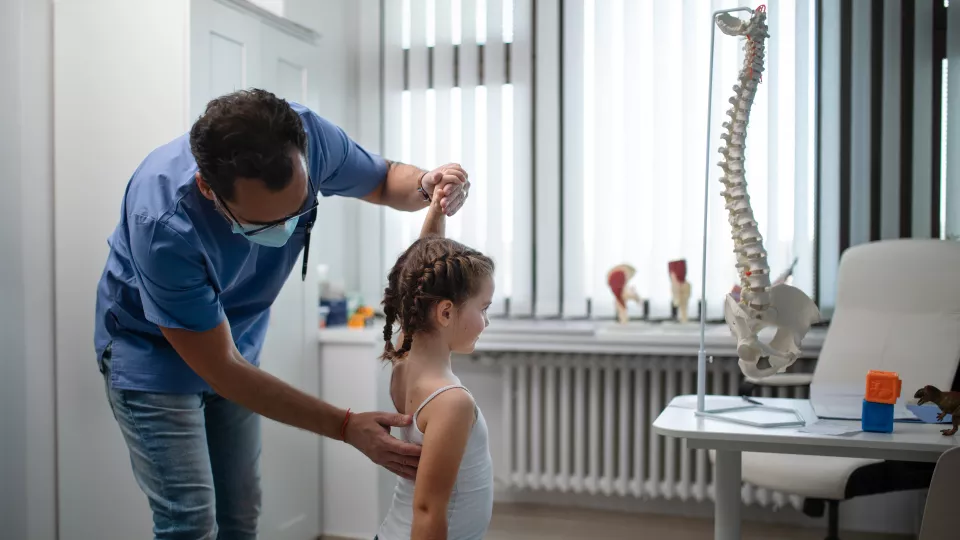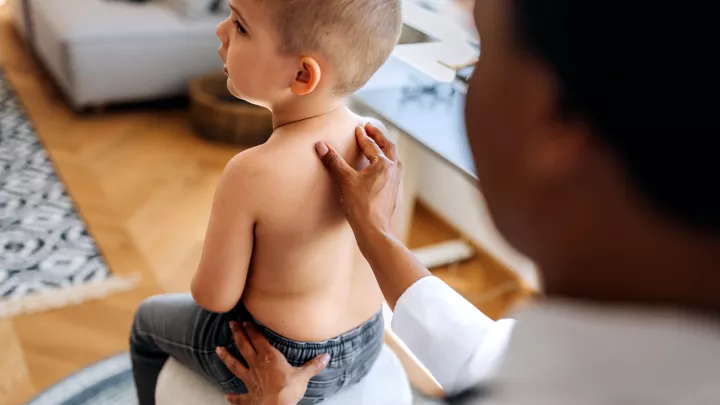
Spinal Fusion Linked to Higher LIV for ‘Tweeners’ With Scoliosis
What is the best approach for children ages 8 to 11 who need surgery for early onset scoliosis? Is it better to implant growing rods—or perform a “one and done” posterior spinal fusion?
There’s no one-size-fits-all answer to that question for patients in this age group, often called “tweeners.” But now, a first-of-its-kind study led by Children’s Hospital Los Angeles has highlighted one more factor to consider when making this choice: lowest instrumented vertebra (LIV).
The study, led by Michael Heffernan, MD, found that children ages 8 to 11 with scoliosis who undergo a posterior spinal fusion are more likely to have a more cephalad LIV (higher in the spine) than those who receive magnetically controlled growing rods.
Dr. Heffernan, a pediatric spine surgeon in the Jackie and Gene Autry Orthopedic Center at Children’s Hospital Los Angeles, presented the results in April at the 31st International Meeting on Advanced Spine Techniques in San Diego—where the study was nominated for the Scoliosis Research Society’s prestigious Thomas E. Whitecloud Award. He shares the findings and what surgeons should know.
Why did you want to study LIV for this age group?

It’s often challenging to figure out the best approach for these tweener patients. If we do a fusion, there’s a concern we’re sacrificing their remaining growth. If we choose a growth-friendly approach, there’s a higher risk of complications, and we don’t achieve as much curve correction.
But while other studies have compared these two strategies, we wanted to know whether this choice affects how low or high the LIV is. That’s important because limiting the LIV—fusing fewer levels in the lumbar spine—can help maintain lower back flexibility and reduce the risk for disc degeneration in adulthood.
What did you find?
Using the Pediatric Spine Study Group database, we looked at 159 children ages 8-11 with scoliosis. Of those, 82 kids received magnetically controlled growing rods, and 77 kids had a posterior spinal fusion.
The majority of patients in both groups had an LIV at L3 or below, which was likely driven by curve magnitude. But we also found that patients treated with a fusion were more likely to have a more cephalad LIV selection than those with growing rods. For example, 68% of fusion patients had an LIV above the stable vertebra, compared with 48% of patients with growing rods.
It’s important to note that we were comparing LIV only at the time of the index surgery. When patients with growing rods have their final fusion years later, the LIV can drop down another level. We didn’t have enough data to make that comparison. But it’s possible the final difference in LIV between the two groups is even bigger than what this study shows.
Why is LIV generally lower in patients with growing rods?
This study didn’t address that question, but we think it’s related to the size of the connector, or actuator, that has to be placed in the spine when you implant growing rods. It’s not easy to fit that connector in, and it tends to fit best in the thoracolumbar spine. I suspect that’s the driving factor.
What is the take-home point for surgeons?
The takeaway is that if you’re choosing between a growth-friendly strategy versus fusion, it’s important to look at what the planned LIV would be under each scenario. Because you may find that a fusion would lead to a more optimal LIV for the child. And that could improve the patient’s quality of life over the long term.
That said, the last tweener patient I saw had a lot of growing left, and we decided on a growth-friendly approach. So I don’t think LIV should be the final decider. But we need to add it to the list of factors we consider. It’s one more piece of information that can help us create the best treatment plan for each individual child.


